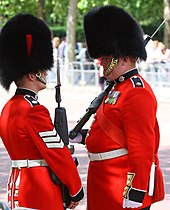Colour sergeant

Colour sergeant(CSgtorC/Sgt) is a rank ofnon-commissioned officerfound in several armies and marine corps.[1]
Australia[edit]
In theAustralian Army,the rank of colour sergeant has only existed in theCorps of Staff Cadetsat theRoyal Military College, Duntroon.[2]
Canada[edit]

Colour sergeant is a rank in theFoot Guardsregimentsof theCanadian Army,specifically in theGovernor General's Foot Guardsand theCanadian Grenadier Guardsand also previously inThe Canadian Guards.It is the equivalent towarrant officer;a colour sergeant wears the rank insignia of a warrant officer (a royal crown) on all uniforms except No. 1 Ceremonial Dress, on which a special rank badge is worn: three chevrons, point down, surmounted by an image of regimental colours.
Canadian colour sergeants are addressed in the same manner as their British counterparts.
United Kingdom[edit]
Colour sergeant (CSgt or C/Sgt) is a non-commissioned title in theRoyal Marinesandinfantryregiments of theBritish Army,ranking abovesergeantand belowwarrant officerclass 2. It has aNATO ranking codeof OR-7 and is equivalent to the rank ofstaff sergeantin other branches of the Army,flight sergeantorchief technicianin theRoyal Air Force,andchief petty officerin theRoyal Navy.The insignia is the monarch's crown above three downward pointing chevrons.


The rank was introduced into British Army infantry regiments in 1813[1]during theNapoleonic Warsto reward long-serving sergeants; a single colour sergeant was appointed to each company as the senior NCO. From 1 October 1913, British infantry battalions were reorganised from eight companies to four, leaving two colour sergeants in each new company. The senior of the pair was appointed to the new rank ofcompany sergeant majorand the junior to that ofcompany quartermaster sergeant.[3][4]Although the rank of colour sergeant was then abolished, the CQMS of an infantry company continued to be generally addressed as "Colour Sergeant" and the rank was later reintroduced, probably during theSecond World War,with CQMS becoming an appointment of it. The Royal Marines retained the rank throughout.
Historically, colour sergeants of British line regiments protectedensigns,the most junior officers who were responsible for carrying theirbattalions'coloursto rally troops in battles. For this reason, to reach the rank of colour sergeant was considered a prestigious attainment, granted normally to those sergeants who had displayed courage on the field of battle. This tradition continues today as colour sergeants form part of a colour party in military parades. During ceremonial events, it is from a colour sergeant that the ensign collects the colour of the battalion or regiment.
Colour sergeants are referred to and addressed as "Colour Sergeant" or "Colour" ( "Colour Sergeant Hewitt" or "Colour Hewitt", for instance) in the Army, or as "Colour Sergeant" or "Colours" in the Royal Marines, and never by the more junior rank of "Sergeant". Unusually, NCOs with the rank of colour sergeant who hold the appointment of company quartermaster sergeant are still addressed and referred to by their rank, not their appointment. In Foot Guards regiments, colour sergeants are addressed as "Sir" and afforded the respect and privileges normally accorded to warrant officers. InThe Rifles,the spelling "colour serjeant" is used, in common with other Rifles ranks and appointments including the wordserjeant.[5]
In theRoyal Marines Band Service,thebandmastersof the sevenRoyal NavyVolunteer Bands usually hold the rank of band colour sergeant.[6][7]The senior playing musician in a Royal Marines band also holds this rank, which replaced the rank of bandmaster in 1969.[8]
Colour sergeants andwarrant officersform an important part of the instructor cadre at theRoyal Military Academy Sandhurst.[9]
United States[edit]

Color sergeant is an NCO rank that was used historically in theUnited States Army,most recently during World War I.[citation needed]Within theUnited States Military Academyat West Point, the term is used to distinguish second class cadets who are assigned to a colour party (one bearer per colour plus two guards).[citation needed].In theVirginia Tech Corps of Cadets,the rank is given to 3rd year cadets that are members of the Regimental Color Guard, with the exception of the guard's NCO-in-command, who holds the rank of cadet command color sergeant. All color sergeants in the VTCC must go through the guard's joining process (Tap) again, even if they served as cadet color corporals on the guard as sophomores.
The term is used in theUS Marine Corpsas a billet forsergeants who carry the colours.Additionally, there is a billet ofColor Sergeant of the Marine Corps,a sergeant (E5) who is the Commandant of the Marine Corps' ceremonial representative and the platoon sergeant of the Marine Corps Battle Colors Detachment.[citation needed]
See also[edit]
References[edit]
- ^abChisholm, Hugh,ed. (1911)..Encyclopædia Britannica.Vol. 6 (11th ed.). Cambridge University Press. p. 731.
- ^"The rank of Colour Sergeant in the Australian Army".www.diggerhistory.info.Retrieved2 March2022.
- ^"Four-Company Battalions",The Times,17 September 1913
- ^"New Rates of Pay in the Army",The Times,14 October 1913
- ^"Colour Serjeant Kevin Charles Fortuna killed in Afghanistan", Ministry of Defence, 25 May 2011
- ^"HMS Collingwood Volunteer Band support RAF100 event", Royal Navy, 20 April 2018
- ^"Plymouth Royal Navy volunteer band success",Somerset County Gazette,22 July 2014
- ^"Royal Marines - Band Services - Introduction of the Rank of Band Colour Sergeant", 28 February 1969
- ^Blackhurst, Rob (20 November 2012)."New model army: Sandhurst's officers of the future".ISSN0307-1235.Retrieved29 January2018.
